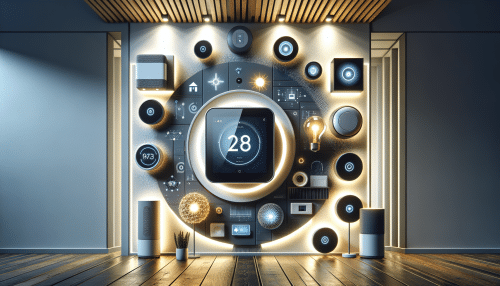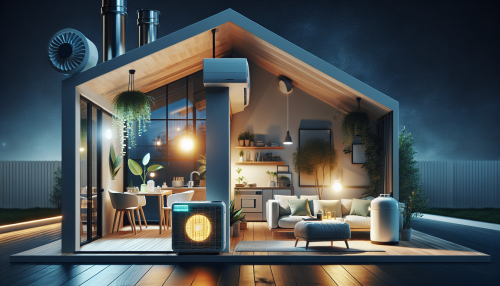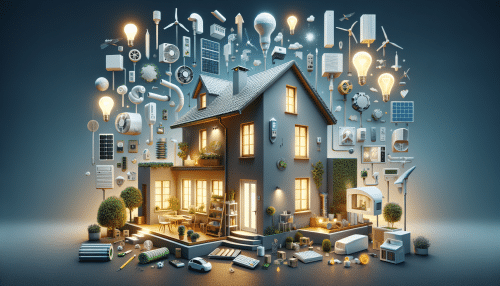Smart Ways You Can Save Energy At Home
Olivia Morgan November 13, 2025
Discover practical strategies that help you save energy at home, from optimizing lighting and appliances to using smart technology. This guide explores how simple changes can reduce your bills, increase comfort, and contribute to a more sustainable lifestyle—while delivering actionable ideas for every home.
Understanding Home Energy Consumption
When considering how to save energy at home, it is helpful to understand where most household electricity goes. Typically, the largest portions are dedicated to heating and cooling, followed by water heating, lighting, appliances, and electronics. By identifying which systems or behaviors consume the most energy, it becomes easier to target the right areas for changes. Even minor adjustments, such as turning off unused lights or moderating thermostat settings, can have a measurable impact over time (Source: https://www.energy.gov/energysaver/estimating-appliance-and-home-electronic-energy-use).
Understanding your energy bill is another essential step. Most providers show detailed breakdowns of electric and natural gas usage, revealing trends and peak periods. This information highlights not only the total consumption but also the billing structure—such as time-of-use rates, which charge more during peak demand. Monitoring this data helps residents identify opportunities to shift activities and make conscious choices, like running laundry machines during off-peak hours. Over months, these habits can significantly affect your costs.
Taking stock of energy-consuming habits and devices forms the foundation of an effective savings plan. Making a quick inventory of major appliances—refrigerators, washers, dryers, dishwashers, entertainment centers—and checking their age or efficiency ratings can point to potential upgrades. Awareness about how much each device or routine contributes allows for more targeted interventions. Many people are surprised by how much energy standby electronics, sometimes called “phantom loads,” can use even when turned off (Source: https://www.energystar.gov/products/appliances/energy-efficient-appliances).
Optimizing Lighting For Energy Efficiency
Lighting accounts for a substantial portion of household energy use, but modern LED technology has transformed the landscape. Switching out incandescent or halogen bulbs for LEDs can cut lighting-related consumption by up to 80%. LED bulbs last years longer, produce less heat, and are available in a variety of color temperatures to suit any room. For homeowners still using older bulb types, prioritizing high-use spaces—like kitchens, living rooms, or outdoor areas—for immediate upgrades delivers fast results.
Enhancing natural light also reduces reliance on artificial lighting during the day. Using light-colored paint, adding mirrors, or arranging furniture to take advantage of windows can make spaces feel brighter without extra energy expenditure. Installing dimmer switches or motion sensors in hallways and bathrooms can further streamline lighting use, ensuring lights are only on when needed. Tiny adjustments like opening curtains at sunrise or setting outdoor lights to timers contribute to cumulative savings (Source: https://www.energy.gov/energysaver/save-electricity-and-fuel/lighting-choices-save-you-money).
Behavioral changes in everyday routines matter, too. Encouraging family members to turn off lights upon leaving a room has immediate effects. When choosing new fixtures, consider models designed to use less energy or that optimize bulb output. These strategies, when combined, offer a straightforward way to make home lighting more efficient without losing comfort or visibility. Over time, lowering lighting costs opens resources for more impactful home upgrades.
Choosing Energy Efficient Appliances And Devices
The selection of appliances can have a tremendous influence on home energy consumption. ENERGY STAR labeled appliances, certified by independent testing, use significantly less energy compared to standard models. Replacing aging refrigerators, washers, or air conditioners with new high-efficiency versions leads to immediate reductions in both energy use and utility bills. These savings often offset the higher upfront price within just a few years, depending on frequency of use (Source: https://www.energystar.gov).
Smart appliances add another dimension to efficiency. Many new models allow users to monitor operation and schedule cycles to coincide with off-peak power rates. For example, a programmable washing machine may be set to run overnight when electricity is cheaper. Some smart plugs and power strips track energy use of individual devices and can be turned off remotely to reduce phantom loads. Integrating smart home technology helps find and eliminate hidden sources of wastage.
Routine appliance maintenance is most helpful. Cleaning refrigerator coils, replacing HVAC filters, and ensuring seals on doors and windows are tight ensures devices operate at peak efficiency. Choosing the right appliance size also matters; oversize units may waste energy trying to cool, freeze, or heat spaces larger than necessary. Evaluating the features you need—rather than opting for the largest or most complex model—leads to smarter energy decisions every time.
Managing Heating And Cooling For Lower Bills
Heating and cooling are the biggest energy users in most homes, but also the area where small changes make a big difference. Setting thermostats just a few degrees lower in winter or higher in summer can yield substantial savings. Layering clothing or using ceiling fans for air circulation helps maintain comfort without excessive HVAC reliance. Programmable or smart thermostats take the guesswork out, automatically adjusting temperatures based on occupancy patterns or the time of day (Source: https://www.epa.gov/heating-and-cooling).
Weatherizing your home ensures heating and cooling systems do not work harder than necessary. Sealing windows, doors, and ductwork reduces drafts. Adding insulation in attics or walls maintains stable indoor temperatures without constant mechanical adjustment. These upgrades can be simple and budget-friendly, especially when using DIY kits available from home improvement stores. Efficient weatherization can reduce total energy expenses by 10-20% year-round.
Regular HVAC system maintenance is crucial. Scheduling annual inspections, changing filters monthly during high-use seasons, and cleaning vents all improve air quality and performance. Evaluating your current system’s age or efficiency rating also helps; older furnaces or air conditioners may merit replacement with more modern, efficient models. Upgrading old or single-pane windows to double or triple-pane designs also minimizes energy loss, especially in extreme climates.
Smart Home Technology And Behavior Changes
Smart home devices are making it easier for homeowners to monitor and control their energy use. Popular options include smart thermostats, which learn your routines and optimize heating and cooling, or smart plugs that allow remote control of multiple electronics. Many smart hubs provide real-time usage data, helping users spot problem areas or unexpected surges in consumption (Source: https://www.consumerreports.org/appliances/how-to-save-energy-at-home-a1194993305/).
Adopting new habits can be just as impactful as new technology. Forming routines such as unplugging devices when not in use, setting a regular schedule for turning off lights, or leveraging natural ventilation in mild months can reinforce long-term savings. Many families create energy checklists—a quick walk-through before bed or leaving home—to ensure nothing is left running unnecessarily. Behavioral tools like sticky notes or scheduled reminders can help new habits stick.
Combining strategies often generates the best results. Using smart home systems to automate certain actions while simultaneously promoting energy mindfulness creates an environment where everyone participates in savings. Over time, this multi-pronged approach not only curbs energy costs but demonstrates that sustainable living at home need not sacrifice comfort or convenience. Sharing results with household members can keep motivation high for the entire family.
Exploring Incentives And Long-Term Energy Solutions
Many regions provide incentives and rebates for energy-saving upgrades, from high-efficiency appliances to solar panel installations. Checking with local utility companies or government agencies offers insight about qualifying programs, grants, or tax credits. These initiatives lower the cost barrier and accelerate the return on investment for improvements like smart thermostats, insulation, or window upgrades (Source: https://www.energy.gov/savings).
In addition to these incentives, some homeowners explore larger-scale changes, like installing solar panels or geothermal heating systems. While the upfront investment is higher, long-term reductions in monthly bills and decreased carbon footprint make these options attractive for those committed to sustainability. Many organizations provide education and technical support for renewable energy adoption, making the process smoother and more accessible.
Planning for widespread improvements can start simply—with a home energy audit. Many utilities offer free or discounted audits, performed either in-person or virtually. These services identify air leaks, insulation gaps, inefficient appliances, and opportunities for easy upgrades. By acting on audit recommendations, residents optimize their savings strategies and make the most of available programs or resources.
References
1. U.S. Department of Energy. (n.d.). Estimating Appliance and Home Electronic Energy Use. Retrieved from https://www.energy.gov/energysaver/estimating-appliance-and-home-electronic-energy-use
2. ENERGY STAR. (n.d.). Energy-Efficient Appliances. Retrieved from https://www.energystar.gov/products/appliances/energy-efficient-appliances
3. U.S. Department of Energy. (n.d.). Lighting Choices to Save You Money. Retrieved from https://www.energy.gov/energysaver/save-electricity-and-fuel/lighting-choices-save-you-money
4. U.S. Environmental Protection Agency. (n.d.). Heating & Cooling. Retrieved from https://www.epa.gov/heating-and-cooling
5. Consumer Reports. (n.d.). How to Save Energy at Home. Retrieved from https://www.consumerreports.org/appliances/how-to-save-energy-at-home-a1194993305/
6. U.S. Department of Energy. (n.d.). Tax Credits, Rebates & Savings. Retrieved from https://www.energy.gov/savings





